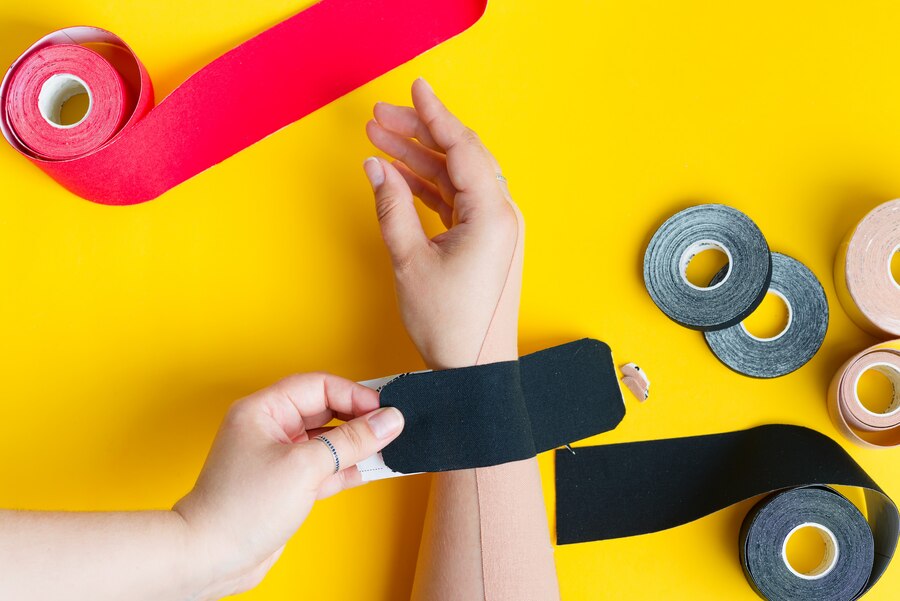
In the world of sports, every edge counts. Athletes are always on the lookout for ways to boost their performance and prevent injuries. Enter sports tape—a game-changer that has become a staple in the toolkit of athletes and trainers alike. From enhancing muscle stability to providing joint support, sports tape has revolutionized the way we approach physical fitness. In this blog post, we’ll explore the fascinating world of sports tape, its various types, benefits, and application techniques. Read on to find out how you can incorporate this versatile tool into your own fitness routine.
Sports tape has come a long way since its inception. The use of tape in sports dates back to the early 20th century when athletes began experimenting with different materials to support injuries. However, it wasn’t until the 1970s that sports tape gained significant traction, thanks to Dr. Kenzo Kase. Dr. Kase developed kinesiology tape, a revolutionary product designed to mimic the skin’s elasticity and provide support without restricting movement. Since then, sports tape has evolved into various forms, each with its unique properties and applications.
Kinesiology tape is perhaps the most well-known type of sports tape. It’s designed to support muscles and joints without restricting movement. Made from a stretchy, breathable material, kinesiology tape can be worn for extended periods, even during intense physical activities. Its adhesive properties allow it to stay in place while providing continuous support.
Rigid tape, also known as athletic tape, is a non-elastic adhesive tape used to immobilize joints and restrict movement. It’s commonly used in sports like football, basketball, and rugby to provide stability to injured areas. Rigid tape is ideal for preventing further injury and promoting healing by limiting the range of motion.
Elastic adhesive bandages (EAB) combine the benefits of both rigid and kinesiology tape. They offer flexibility while providing strong support to muscles and joints. EAB is particularly useful for dynamic sports where both stability and movement are crucial. It’s often used to wrap around larger areas like thighs and shoulders.
One of the primary benefits of sports tape is its ability to prevent injuries. By providing additional support to muscles and joints, sports tape helps reduce the risk of strains, sprains, and other common sports-related injuries. Athletes can perform at their best without worrying about potential setbacks.
Sports tape doesn’t just prevent injuries; it can also enhance performance. By improving muscle activation and proprioception (the body’s sense of position and movement), sports tape allows athletes to execute movements more efficiently. This leads to better performance and quicker recovery times.
Certain types of sports tape, like kinesiology tape, can improve blood circulation in the taped area. This increased blood flow helps reduce inflammation and promotes faster healing. Improved circulation also means that nutrients and oxygen are delivered more efficiently to the muscles, aiding in recovery and performance.
Different sports and activities require different levels of support. For high-impact sports like football or rugby, rigid tape may be the best choice for providing maximum stability. For activities that require a full range of motion, like swimming or gymnastics, kinesiology tape might be more appropriate.
The type of injury you’re dealing with will also influence your choice of sports tape. For acute injuries that require immobilization, rigid tape is the way to go. For chronic issues like muscle soreness or joint pain, kinesiology tape can provide ongoing support and relief.
Ultimately, the best sports tape for you will depend on your personal preferences and needs. Some athletes prefer the feel of kinesiology tape, while others find rigid tape more supportive. It’s essential to experiment with different types to find the one that works best for you.
 Application Techniques for Sports Tape
Application Techniques for Sports TapeBefore applying sports tape, make sure the skin is clean and dry. Shaving the area can help the tape adhere better and reduce discomfort when removing it. Use an alcohol wipe to remove any oils or lotions.
To apply kinesiology tape, start by cutting the tape to the desired length. Round the edges to prevent peeling. Stretch the tape slightly and apply it to the skin, following the muscle or joint’s natural direction. Rub the tape to activate the adhesive and ensure it sticks properly.
When using rigid tape, begin by wrapping the tape around the injured area, making sure to overlap each layer slightly. For added support, use pre-wrap underneath the rigid tape to protect the skin. Finish by securing the end of the tape and checking for any tightness or discomfort.
Many professional athletes have reaped the benefits of sports tape. For example, Serena Williams, a tennis legend, has been seen using kinesiology tape during matches to support her knees and shoulders. This has allowed her to stay at the top of her game despite dealing with chronic injuries.
Sports tape isn’t just for professional athletes. Weekend warriors and fitness enthusiasts can also benefit from its use. For instance, a recreational runner with a history of ankle sprains found that using rigid tape provided the stability needed to continue training without re-injuring the ankle.
Physical therapists often incorporate sports tape into rehabilitation programs for their patients. A case study involving a patient recovering from ACL surgery showed that using kinesiology tape on the affected knee improved muscle activation and range of motion, leading to a quicker recovery.
Sports tape has become an indispensable tool for athletes of all levels. Its ability to prevent injuries, enhance performance, and support rehabilitation makes it a valuable addition to any fitness regimen. Whether you’re a professional athlete or a weekend warrior, incorporating sports tape into your routine can help you stay at the top of your game.
It is a long established fact that a reader will be distracted by the readable content of a page when looking at its layout. The point of using Lorem Ipsum is that it has a more-or-less normal distribution
contact us : laynmade5@gmail.com